Death of a bodybuilder
An article about about Andreas Münzer, after all these years? Why would I do that? Maybe because after Nasser died I've read so many articles about Andi (Andreas) and how he was abused even after his death. I looked into Andi's causes of death and read more autopsy reports and comparisons and decided to merge all this information. I will also post images and information of Andi's organs maybe to warn us al. Bodybuilding on a toplevel is very unhealthy, as many other sports on toplevel, but since this is a bodybuilding blog...

Nasser el Sonbatty: "The German media speculated that "Nasser El Sonbaty" would be the next dead German bodybuilder. I was nicknamed "the walking pharmacy" - pure irresponsible speculation."
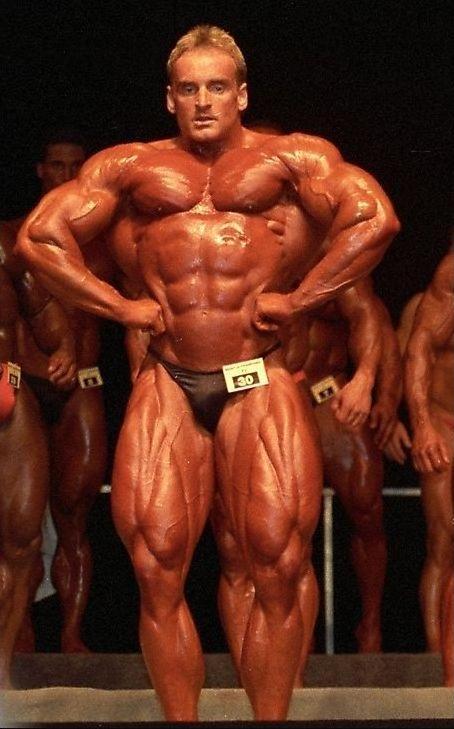 On March 14, 1996, the bodybuilding world awoke to the devastating news that one of its own had died under the most tragic of circumstances. When news broke of bodybuilding great Andreas Münzer's untimely death, yet another shadow of doubt was cast over competitive bodybuilding, another pounding blow was delivered squarely between the eyes of a sport that had received much criticism regarding its alleged close association with the dangerous and abusive use, by its athletes, of anabolic steroids and related "bodybuilding" drugs.
On March 14, 1996, the bodybuilding world awoke to the devastating news that one of its own had died under the most tragic of circumstances. When news broke of bodybuilding great Andreas Münzer's untimely death, yet another shadow of doubt was cast over competitive bodybuilding, another pounding blow was delivered squarely between the eyes of a sport that had received much criticism regarding its alleged close association with the dangerous and abusive use, by its athletes, of anabolic steroids and related "bodybuilding" drugs.
Andreas' death confirmed in the minds of many skeptics the belief that professional bodybuilding, and by implication the general bodybuilding population, was fraught with drug abuse, that those who trained with weights specifically to build their bodies were on a suicide mission of self-destruction by virtue of the consumption of "drugs" required to complete the transformation process.
Whatever the case, with Andreas' death any integrity bodybuilding had had again been significantly compromised, adding to its perpetual corrosion due to an ongoing trial by media that continues to this day.
Andreas, who turned professional with his heavyweight victory at the 1989 IFBB World Amateur Games, was widely regarded as bodybuilding's nicest, most sincere champion. To this author's knowledge not a bad word had, or has ever been said about him.
Andreas was also an unassuming, quiet, humble, hard working competitor, who constantly reached for for perfection, as exemplified by his unsurpassed muscular definition and outstandingly proportionate and massive physique. A true fan favorite, Andreas captivated international audiences with his one of a kind body, fully loaded with 240 pounds of cut-to-shreds muscle, complete with 21-inch arms, ultra-striated chest, and mountain like shoulders.
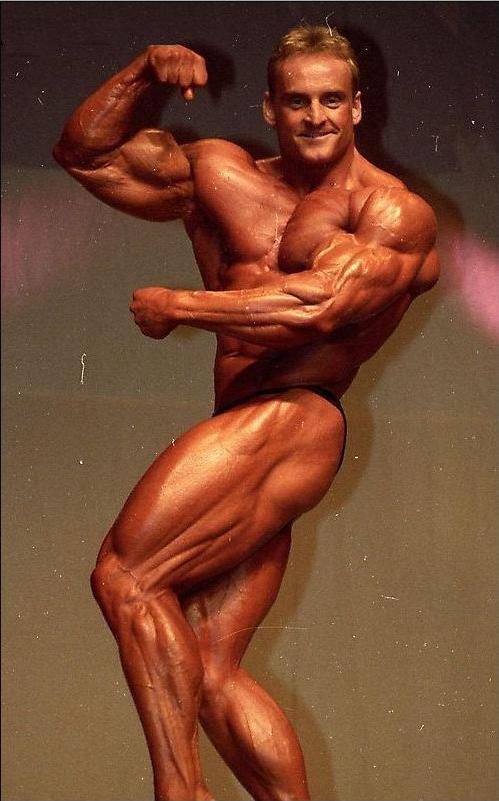 Since his pro debut in 1989 - at the IFBB Mr. Olympia - Andreas maintained an exhaustive schedule, competing every year until his death in '96. Typical for Andreas was his appearance at many bodybuilding contests in one season, which necessitated strict adherence to a low calorie diet and massive quantities of bodybuilding drugs. Was this due to a personal desire to capture a major title, or were there other reasons prompting his apparent need, or 'desire', to stay in top shape all year round?
Since his pro debut in 1989 - at the IFBB Mr. Olympia - Andreas maintained an exhaustive schedule, competing every year until his death in '96. Typical for Andreas was his appearance at many bodybuilding contests in one season, which necessitated strict adherence to a low calorie diet and massive quantities of bodybuilding drugs. Was this due to a personal desire to capture a major title, or were there other reasons prompting his apparent need, or 'desire', to stay in top shape all year round?
After months of stomach pain, Münzer was admitted to hospital on the morning of March 12. By 7pm, doctors had decided to operate to stop bleeding from his stomach, but shortly afterwards his liver and then kidneys failed. His condition by this point was too severe for a blood transfusion—he died on the morning of March 14, aged 31.
Poor placings
On the boards you can read that these guys dedicated there life to poor placing’s on the major bodybuilding stages. Nasser was called “the uncrowned Mr. Olympia” and to some degree, Andy was robbed of better placing’s too Its tragic to sacrifice so much and still don’t get the most desired title while others , rightfully earned or not, win this title years and years in a row.
 What Andy had common with Nasser was the fact that they both competed in a period where there where many bodybuilders that where the living legends of the nineties, some considered the golden years of bodybuilding. In 1996, Andy placed 6th at the Arnold Classic. The guys who were placed above him were Kevin Levrone, Flex Wheeler, Paul Dillet, Vince Taylor, and Shawn Ray.
What Andy had common with Nasser was the fact that they both competed in a period where there where many bodybuilders that where the living legends of the nineties, some considered the golden years of bodybuilding. In 1996, Andy placed 6th at the Arnold Classic. The guys who were placed above him were Kevin Levrone, Flex Wheeler, Paul Dillet, Vince Taylor, and Shawn Ray.
Bodybuilding is a subjective sport, it’s like a singing contest or a beauty contest. If you run cycle or race and you finish first you have won, no arguing about that. In bodybuilding a lot of factors play a role and the judging is often financial interest based and put above the sport. Múnzer had in common with Nasser that they were no Americans. Nasser always felt insecure, him being the son of an Egyptian father and a Serbian mother and born in Germany with an exotic name. That’s why Nasser always mentioned that German tabloids loved them when they were winning and wrote they were just Austrian or Egyptian when times were worse. I don’t think Andy felt that way he was obvious very Arian German.
Andy was nicked “Mr. Ripped”. His paper thin skin, his low body fat and subcutaneous fat was something that was expected of him and something that he would focus on and exploit with each appearance and photo shoot
Some say he got too dieted down for contest too much, was too ripped and too depleted. Because he wanted to hold on to that ultra-dry, ripped look, he did sacrifice some size. To achieve this shape he was unable to gain extra muscle mass and maybe a better placing.
A documentary on YouTube: Andreas Münzer Sein leben Sein tot (his life his death)//www.youtube.com/watch?v=W8whOKqM__0
Nasser el Sonbatty died in his sleep on Wednesday afternoon March 20th 2013, in Cairo, Egypt .Being a Muslim he was buried the next day and no autopsy was performed. Its was known that he suffered from organ damage like Andreas Munzer did so with little doubt we can assume that autopsy on his body would have resulted in similar results. Reading the diverse autopsy reports of such big bodybuilders that without any doubt abused so much drugs for such a long time shows what these roid- cocktails and diuretics and painkillers do with our organs on the long run.
 The autopsy gave the cause of death as dystrophic multiple-organ-failure.Some of the specific autopsy findings:
The autopsy gave the cause of death as dystrophic multiple-organ-failure.Some of the specific autopsy findings:
An extremely muscular physique, with an almost complete absence of subcutaneous fat.
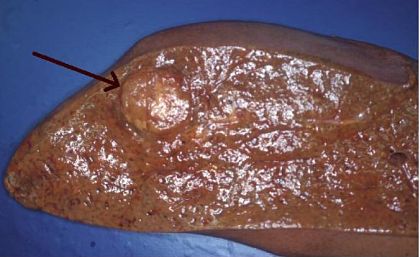 Affecting the liver were numerous table-tennis-ball-sized tumors; half the liver consisted simply of a crumbly mass, similar to polystyrene (Styrofoam)
Affecting the liver were numerous table-tennis-ball-sized tumors; half the liver consisted simply of a crumbly mass, similar to polystyrene (Styrofoam)
His liver (picture) weighed 2879 gram (normal liver weight is between 1500- 2000g), it showed yellow dystrophy , multiple adenomas , periportal fibrosis,
Bile duct proliferation, centrilobular cholestasis.
Picture: testicular atrophy with anabolic steroid abuse (right) compared to a normal testes 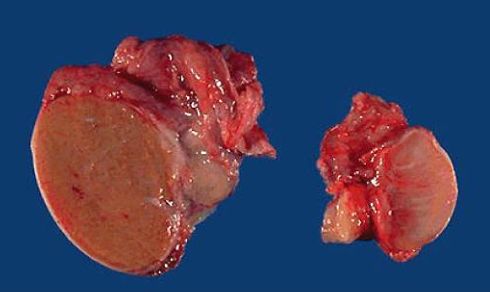
Andreas'seminal vesicles contained a small amount of thickened secretion
His testicels showed testicular atrophy (hazelnut size) , with a walnut large cyst formation on the right testicel.
Brain 1363 gram low grade cerebral edema, hypoxic nerve cell changes ,
granule cell necrosis
Pancreatic fibrosis
Skin: overstretching scar along the anterior axillary folds , significant receding hairline, multiple injection sites on both forearms
Lungs: shock lung
Kidneys: Sparse kidney fat, very large, swollen , slurred mark bark drawing, mild atherosclerosis
Adrenal gland: Very narrow adrenal medulla Thyroid: Very small thyroid
Cardiac hypertrophy (Münzer's heart weighed 636g; a normal man's heart usually weighs 300-350 gr)finely mottled myocardial fibrosis, mild arterio sclerosis
Münzer's electrolytes were also completely out of balance, and his potassium levels were extremely high. Traces of about twenty different drugs were found in his blood, along with acute toxicity (perhaps caused by a stimulant). Analysis only showed :4 -hydroxy- 3 stanozolol andmethylaminoantipyrine
Analysis on urine and hair were not performed .
*************
From “The Observer” Sunday October 31, 2004 The writer took most information from an article in "Der Spiegel" ("The Mirror") called Blond, stark und tot
Andreas Münzer dreamed of emulating his hero, fellow Austrian and bodybuilder Arnold Schwarzenegger.
Two careers - one of riche and fame that may yet lead to the White House, and another that ended in drugs and disaster.
He went to the stage as hard as a bag full of nails. He looked like the eighth wonder of the world up there: 17 stone of muscle and bone and not much else. He was huge and dense and cut. He had 21-inch arms, a 58-inch chest and enough junk in his bloodstream to kill a horse. It was certainly killing him. He lived in agony. If he had still had the will to turn his head to the left, he would have seen other men like him, Godzillas of the iron game. To his right, the same. They looked barely human.
They looked like a sub-strain, a spin-off, a genetic joke.
He was so dry that his lips kept sticking together. His body was arid. The last of his sweat rolled slowly down him, streamed by his deep striations. It left light streaks in his tinned tan. Andi fixed his feet harder into the floor and squeezed his unsteady muscle one more time.
The other guys still had some zap and heft and zing left in them. Kevin Levrone, 'The Maryland Muscle Machine', was ripped and zipped; Kenny 'Flex' Wheeler was as austere and beautiful as a Greek statue; Paul Dillett had a chest by Jackson Pollock, splattered with fat chunks of vein; Vince Taylor brought out his galactic shoulders; Shawn Ray ran as thick as a bull, front to back. It was a war of the strangest kind. Huge men in spangly thongs shoved each other aside so they could hit muscleman poses. There were 4,000 people watching them do it and they were going off while they did. The Veterans' Memorial Arena was a mushroom farm of jumping muscle. Most of the crowd were bodybuilders of a sort themselves - there were women who could have beaten the living crap out of you.
Andi already knew that the game was up. This was the final round of competition, the posedown - a concocted crowd-pleaser. It existed mainly to allow the judges time to verify the scores. Levrone, Ray and Dillett jumped from the stage and walked into the stalls so the fans could see them close up. They posed for photos. They gripped and grinned. Andi held on at the edge of the platform. There, perhaps one more judge might catch the final nuances of his development. Perhaps one more judge might move him up by one more place. Perhaps Arnold Schwarzenegger himself would look up from his seat in row two and understand that Andi's head had blazed with his name for 20 years. Perhaps then he would finally get his due and perhaps it would tip the balance of his life. His name was Andreas Munzer. For a decade, he had been the greatest bodybuilder in the German-speaking world.
Head judge Wayne DeMilia called the last six competitors into line. Schwarzenegger now stood in the wings ready to present the prizes. He had not been a bodybuilder for a long time; it had been 16 years since he was Mr Olympia 1980. But he remained the talisman of muscle. The Arnold Classic contest was named after him, promoted by him and dedicated to his glory.
In professional bodybuilding events, results were announced in reverse order. Andi would die soon, but he wouldn't die wondering. DeMilia said: 'Sixth place ... winning five thousand dollars ... from Austria ... Andreas Munzer...'
Andi picked up a slim cheque and a joke trophy. The applause was thin and slow. The crowd already had Munzer sixth. This was how things often were at the top shows. The consensus of years informed results. The judges had muscle memory, too.
 There was a truism in bodybuilding: be born black or German. These were the favored genetic lines. Through them, muscle thrummed down generations. Andi's people were farmers, 'simple with weather-tanned faces' as the press would later describe them. They lived a mile or so from the Modriacher Stausee reservoir near a village called Pack in the rural Austrian region of Styria. They ran a dairy business that just about kept them afloat. Andi absorbed their ethic of stoic self-improvement. He was a quiet boy and a hard worker. Andi paid his dues in the fields. He liked to play the trumpet in a local band, a Musikkapelle. During the summer, he played football. During winter, he skied.
There was a truism in bodybuilding: be born black or German. These were the favored genetic lines. Through them, muscle thrummed down generations. Andi's people were farmers, 'simple with weather-tanned faces' as the press would later describe them. They lived a mile or so from the Modriacher Stausee reservoir near a village called Pack in the rural Austrian region of Styria. They ran a dairy business that just about kept them afloat. Andi absorbed their ethic of stoic self-improvement. He was a quiet boy and a hard worker. Andi paid his dues in the fields. He liked to play the trumpet in a local band, a Musikkapelle. During the summer, he played football. During winter, he skied.
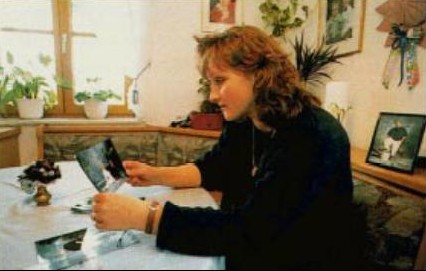
Andi's God was Schwarzenegger. Arnold was Austrian. Moreover, Arnold was Styrian. Arnold came from Thal, Andi from Pack. Arnold took up bodybuilding after seeing a muscleman working out by a mountain reservoir. Andi grew up by one. Arnold became the greatest bodybuilder in the German-speaking world. Andi was striving towards that end. Arnold was a seven-time Mr Olympia. Now he was a movie star, perhaps the planet's most driven man.
In the gyms, everyone was juicing. To succeed in professional bodybuilding, you had to. But you had to do many other things too. If winning pro shows was as easy as taking steroids, every loser iron-junkie, every tragic muscle rat, would be Mr Olympia.
Somehow, somewhere, at some point, Andi joined in. He had no choice. In chess, there is a position called zugzwang, where you must make a move, even though that move will cause you to lose. Drugs were Andi's zugzwang. Drugs were bodybuilding's zugzwang.
As he became more successful, Andi moved to Munich, where he was known as one of the nicest men in a sport mostly populated by meatheads, narcissists, egoists, attention-seekers, overcompensators and the terminally aggrieved. It was a sport that demanded extremity, so it attracted extremists. Andi was no such thing.
 But he had made the deal. The Munich Andi would play the zugzwang. He hit some heavy cycles: he injected two ampoules of testosterone a day; he took the oral steroids Halotestin and Anabol; he combined them with Masteron and Parabolan; he used between four and 24 units of the growth hormone STH. Steroids aided muscle repair and general recovery; they allowed him to train with greater intensity. He combined different steroid types to maximum effect. He found that STH, the synthetic growth hormone, mimicked human growth hormone; it made everything grow - muscles, bones, organs, tissues. He ate 6-8,000 calories a day to nourish his muscles. He used insulin to stimulate his metabolism and churn the calories more quickly; he used at least five aspirin tablets each morning to thin his blood and help with the pain of training; he used ephedrine and Captagon to increase his intensity on the weights.
But he had made the deal. The Munich Andi would play the zugzwang. He hit some heavy cycles: he injected two ampoules of testosterone a day; he took the oral steroids Halotestin and Anabol; he combined them with Masteron and Parabolan; he used between four and 24 units of the growth hormone STH. Steroids aided muscle repair and general recovery; they allowed him to train with greater intensity. He combined different steroid types to maximum effect. He found that STH, the synthetic growth hormone, mimicked human growth hormone; it made everything grow - muscles, bones, organs, tissues. He ate 6-8,000 calories a day to nourish his muscles. He used insulin to stimulate his metabolism and churn the calories more quickly; he used at least five aspirin tablets each morning to thin his blood and help with the pain of training; he used ephedrine and Captagon to increase his intensity on the weights.
Fifteen weeks or so from competition, he would begin a rigorous diet designed to reduce his body fat. He would come down to 2,000 calories a day. In the days and hours before a show he used Aldactone and Lasix, both diuretics, to rid himself of the last of his water. Most pros would get close to competition shape once or twice a year. Anything else demanded too much; Andi maintained a reputation for always being in shape, or close to it.

The stomach pains had begun some months before Andi went toColumbus, Ohio, for the 1996 Arnold Classic. At first it was just more pain, and pain was the currency of muscle. Andi paid it little heed. It dug in and nestled down with all the other pain: the agonies of training, the banal deprivations of dieting down, the pulls, nicks, strains, jags and twists of the gym. But it kept coming back and its payload was different. A connoisseur of pain like Andi would soon have been able to tell. He would have been able to recognise it and rank it as something special in the pain game, something more exotic than the stuff he usually bore. He began to mention it to friends at the gym. He tried some health cures that would strengthen his stomach lining. Perhaps if Andi had quit training then, if he had turned away from the withering deprivations of another round of competition and stopped juicing he might have survived. Instead, the boy from Pack made himself ready to compete in front of the boy from Thal, in front of his hero.
After his sixth place at the Arnold Classic on 2 March 1996, Andi's mood remained low. 'Man, why don't you laugh?' a German official had said. 'You're the best white guy behind five Negroes.' Andi was never going to laugh at that. Best white guy. Best German speaker. All of the pain and deprivation, all of the gym seminars and pain-filled nights for those worthless epithets.
On the morning of 13 March, Andi's stomach pains became intense. His gut was swollen and hard. His bill had come in. He was fairly sure that this time he couldn't meet it. The debt was too big. The agony grew.
He was taken to hospital. Doctors there diagnosed the bleed, but could not prevent it continuing. He was transferred to the University Clinic. At 7pm, surgeons decided to operate to stop the bleeding inside Andi's stomach. Andi came through the operation, but his problems had multiplied catastrophically. His blood was viscous and slow-moving. His potassium levels were excessively high. He had been dehydrated by the diuretics he used in the days before his last competitions. His liver was melting. A post-mortem would find that it had dissolved almost completely. Andi's body went into shock. After his liver failed, his kidneys did too. He was offered a blood transfusion, but it was too late. Andi's heart held out for a while - he had always had a big heart - but by morning Munzer had joined the ranks of the bodybuilding dead.
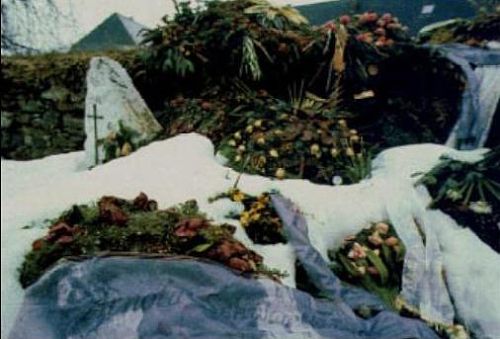
Schwarzenegger sent a wreath to Münzer's funeral in Styria, with the message 'A last greeting to a friend.
'Andreas Munzer became the first bodybuilder to have a play written about him. Well, it was part of a play at least, a very long play by the Austrian writer Elfriede Jelinek, best known for the novel The Piano Teacher and who last month won the 2004 Nobel Prize for literature. The play was called Ein Sportstück (A Sports Play). When it premiered in Vienna in 1998 it received a 55-minute standing ovation. Jelinek's themes were intellectual and postmodern. Ein Sportstück was about mediated realities, lives experienced through other mediums: television, movies, sport. She used Andi's hollowed body to stress the primacy of surface over depth. She said that Andi's freaky frame had been manufactured for rapid consumption and then thrown away. You had to be patient to get to Andi's bit: Ein Sportstück lasted for five hours.
And so Andi's body became metaphor, too. He represented something to bodybuilding, and something else to the wider world. In death, Andi had become someone on to whom things could be projected: ideas, theories, prejudices. He could be interpreted, reinterpreted, misinterpreted.
My vision of Andi was mediated, too. I had the raw facts of his life and death; they had all been well reported. I had the views of other bodybuilders, some of whom had been Andi's friends. I had some theories of my own about him. But I was unable, or perhaps unwilling, to get any closer.
Andi rode the curve. He made the deal. He played the zugzwang. In Munich, he doubled himself. He understood what it would take to make it with a body like his in the earliest years of the era of the freak.
- Login to post comments


